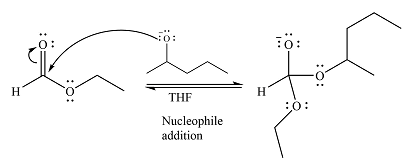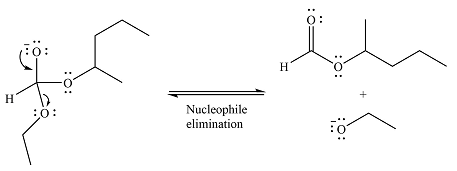
(a)
Interpretation:
The detailed mechanism and the major product of the given reaction is to be drawn.
Concept introduction:
The carbonyl carbon atom in compounds such as
Answer to Problem 20.1P
The mechanism of the given reaction can be drawn as

The major product of the reaction is

Explanation of Solution
The given reaction is

The carbonyl carbon in the ester substrate is partially positively charged, i.e., electron-poor. The reagent

In the next step, the leaving group, the phenoxy ion, from the original ester is eliminated. This step forms the major product, another ester.

Since the substrate and the product are both esters, of comparable stability, the two steps are reversible.
Thus, the complete detailed mechanism for the reaction can be drawn as

And the major product of the reaction is

The mechanism of the reaction and the major product were drawn based on nucleophilic addition-elimination step.
(b)
Interpretation:
The detailed mechanism of the reaction and its major product are to be drawn.
Concept introduction:
The carbonyl carbon atom in compounds such as aldehydes, ketones, and esters is relatively electron-poor. It can add a nucleophile, forming a tetrahedral transition state. This is followed by the elimination of the leaving group, itself a nucleophile, to form the product. When an ester is treated with an alkoxide, it replaces the original alkoxide group in from the ester substrate. Since the reaction results in formation of another ester, it is known as transesterification.
Answer to Problem 20.1P
The complete mechanism for the reaction can be drawn as

And the major product of the reaction as

Explanation of Solution
The given reaction is

The substrate is an ester, with an electron-poor carbonyl carbon. The reagent is ionic and essentially acts as the negativey charged nucleophile

Next, the leaving group (ethoxide) from the original ester is eliminated to formt eh major product.

The major product is another ester, of comparable stability. Therefore, both steps will be reversible steps.
Thus, the complete mechanism for the reaction can be drawn as

And the major product of the reaction as

The complete mechanism and the major product of the reaction were drawn based on nucleophilic addition-elimination steps.
Want to see more full solutions like this?
Chapter 20 Solutions
Organic Chemistry: Principles And Mechanisms
- (12) Which one of the following statements about fluo- rometry is FALSE? a) Fluorescence is better detected at 90 from the exci- tation direction. b) Fluorescence is typically shifted to longer wave- length from the excitation wavelength. c) For most fluorescent compounds, radiation is pro- duced by a transitionarrow_forwardDon't used Ai solutionarrow_forwardDon't used Ai solutionarrow_forward
- Don't used Ai solutionarrow_forwardIndicate the correct option.a) Graphite conducts electricity, being an isotropic materialb) Graphite is not a conductor of electricityc) Both are falsearrow_forward(f) SO: Best Lewis Structure 3 e group geometry:_ shape/molecular geometry:, (g) CF2CF2 Best Lewis Structure polarity: e group arrangement:_ shape/molecular geometry: (h) (NH4)2SO4 Best Lewis Structure polarity: e group arrangement: shape/molecular geometry: polarity: Sketch (with angles): Sketch (with angles): Sketch (with angles):arrow_forward
- 1. Problem Set 3b Chem 141 For each of the following compounds draw the BEST Lewis Structure then sketch the molecule (showing bond angles). Identify (i) electron group geometry (ii) shape around EACH central atom (iii) whether the molecule is polar or non-polar (iv) (a) SeF4 Best Lewis Structure e group arrangement:_ shape/molecular geometry: polarity: (b) AsOBr3 Best Lewis Structure e group arrangement:_ shape/molecular geometry: polarity: Sketch (with angles): Sketch (with angles):arrow_forward(c) SOCI Best Lewis Structure 2 e group arrangement: shape/molecular geometry:_ (d) PCls Best Lewis Structure polarity: e group geometry:_ shape/molecular geometry:_ (e) Ba(BrO2): Best Lewis Structure polarity: e group arrangement: shape/molecular geometry: polarity: Sketch (with angles): Sketch (with angles): Sketch (with angles):arrow_forwardDon't used Ai solutionarrow_forward
 ChemistryChemistryISBN:9781305957404Author:Steven S. Zumdahl, Susan A. Zumdahl, Donald J. DeCostePublisher:Cengage Learning
ChemistryChemistryISBN:9781305957404Author:Steven S. Zumdahl, Susan A. Zumdahl, Donald J. DeCostePublisher:Cengage Learning ChemistryChemistryISBN:9781259911156Author:Raymond Chang Dr., Jason Overby ProfessorPublisher:McGraw-Hill Education
ChemistryChemistryISBN:9781259911156Author:Raymond Chang Dr., Jason Overby ProfessorPublisher:McGraw-Hill Education Principles of Instrumental AnalysisChemistryISBN:9781305577213Author:Douglas A. Skoog, F. James Holler, Stanley R. CrouchPublisher:Cengage Learning
Principles of Instrumental AnalysisChemistryISBN:9781305577213Author:Douglas A. Skoog, F. James Holler, Stanley R. CrouchPublisher:Cengage Learning Organic ChemistryChemistryISBN:9780078021558Author:Janice Gorzynski Smith Dr.Publisher:McGraw-Hill Education
Organic ChemistryChemistryISBN:9780078021558Author:Janice Gorzynski Smith Dr.Publisher:McGraw-Hill Education Chemistry: Principles and ReactionsChemistryISBN:9781305079373Author:William L. Masterton, Cecile N. HurleyPublisher:Cengage Learning
Chemistry: Principles and ReactionsChemistryISBN:9781305079373Author:William L. Masterton, Cecile N. HurleyPublisher:Cengage Learning Elementary Principles of Chemical Processes, Bind...ChemistryISBN:9781118431221Author:Richard M. Felder, Ronald W. Rousseau, Lisa G. BullardPublisher:WILEY
Elementary Principles of Chemical Processes, Bind...ChemistryISBN:9781118431221Author:Richard M. Felder, Ronald W. Rousseau, Lisa G. BullardPublisher:WILEY





